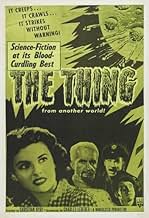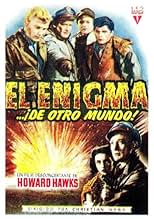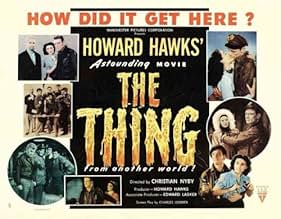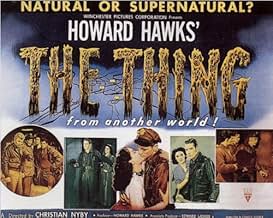NOTE IMDb
7,0/10
36 k
MA NOTE
Des scientifiques et des militaires américains repoussent un organisme extra-terrestre assoiffé de sang dans un avant-poste isolé de l'arctique.Des scientifiques et des militaires américains repoussent un organisme extra-terrestre assoiffé de sang dans un avant-poste isolé de l'arctique.Des scientifiques et des militaires américains repoussent un organisme extra-terrestre assoiffé de sang dans un avant-poste isolé de l'arctique.
- Réalisation
- Scénario
- Casting principal
- Récompenses
- 1 victoire au total
Edmund Breon
- Dr. Ambrose
- (non crédité)
Nicholas Byron
- Tex Richards
- (non crédité)
John Dierkes
- Dr. Chapman
- (non crédité)
George Fenneman
- Dr. Redding
- (non crédité)
Lee Tong Foo
- Lee - a Cook
- (non crédité)
Paul Frees
- Dr. Vorhees
- (non crédité)
Everett Glass
- Dr. Wilson
- (non crédité)
Avis à la une
Classic, wonderful sci-fi / horror feature, a none too faithful adaptation of the John W. Campbell, Jr. short story "Who Goes There?". In this instance, the idea of the alien entity being a monstrosity that can imitate other life forms is jettisoned, in favour of making the creature basically like the Frankenstein monster. It's a super vegetable that requires blood for sustenance, and it makes life very tense for the scientists and military personnel at an isolated Arctic outpost when it's thawed from an icy imprisonment.
With an intrepid hero in the form of 1950s icon Kenneth Tobey on hand, it's a guarantee that "The Thing from Another World" is going to be a good time. It was a fairly odd choice of material for the producer Howard Hawks, who fills the story with overlapping dialogue and a sense of camaraderie among the various protagonists. Unlike the 1982 version, where the characters had the means to destroy the creature but first had to *identify* who the creature was, our cast here have to improvise their survival.
While any genre fan such as this viewer, who'd been brought up on the 1982 John Carpenter film, may be more inclined to favour that brand of horror, this is still very stylish fun. Hawks's editor Christian Nyby gets the directing credit, but it's generally believed that Hawks was pretty much in control of things. The score by Dimitri Tiomkin, utilizing the theremin, is suitably eerie. There are solid shocks, moments of suspense, and atmosphere along the way, as well as a lively finish.
This is a film very much of its time, with our military characters very much a dependable bunch of heroes, and the scientists (most of them) treated as highly suspect, especially the misguided Dr. Carrington, played delightfully by Robert Cornthwaite.
A little too much time is devoted to the romantic subplot with Captain Hendry and his love interest (Margaret Sheridan), but the actors couldn't be more engaging. Tobey, Sheridan, and Cornthwaite are extremely well supported by a strong ensemble: Douglas Spencer as annoying newspaperman Scotty (who has the honour of uttering the memorable closing monologue), James Young, Dewey Martin, Robert Nichols, William Self, Eduard Franz, Nicholas Byron, John Dierkes, George Fenneman, Paul Frees, David McMahon, and Norbert Schiller. A young James Arness, in his pre-'Gunsmoke' days, has great presence as The Thing.
There are images here so striking that Carpenter was wise to pay homage to them in his film: the line of men encircling the buried UFO, and the sight of the burning creature crashing through the building into the snow.
It's definitely a different beast, in more ways than one, than what we would see 31 years later, but it's solid entertainment for its own very good reasons.
Eight out of 10.
With an intrepid hero in the form of 1950s icon Kenneth Tobey on hand, it's a guarantee that "The Thing from Another World" is going to be a good time. It was a fairly odd choice of material for the producer Howard Hawks, who fills the story with overlapping dialogue and a sense of camaraderie among the various protagonists. Unlike the 1982 version, where the characters had the means to destroy the creature but first had to *identify* who the creature was, our cast here have to improvise their survival.
While any genre fan such as this viewer, who'd been brought up on the 1982 John Carpenter film, may be more inclined to favour that brand of horror, this is still very stylish fun. Hawks's editor Christian Nyby gets the directing credit, but it's generally believed that Hawks was pretty much in control of things. The score by Dimitri Tiomkin, utilizing the theremin, is suitably eerie. There are solid shocks, moments of suspense, and atmosphere along the way, as well as a lively finish.
This is a film very much of its time, with our military characters very much a dependable bunch of heroes, and the scientists (most of them) treated as highly suspect, especially the misguided Dr. Carrington, played delightfully by Robert Cornthwaite.
A little too much time is devoted to the romantic subplot with Captain Hendry and his love interest (Margaret Sheridan), but the actors couldn't be more engaging. Tobey, Sheridan, and Cornthwaite are extremely well supported by a strong ensemble: Douglas Spencer as annoying newspaperman Scotty (who has the honour of uttering the memorable closing monologue), James Young, Dewey Martin, Robert Nichols, William Self, Eduard Franz, Nicholas Byron, John Dierkes, George Fenneman, Paul Frees, David McMahon, and Norbert Schiller. A young James Arness, in his pre-'Gunsmoke' days, has great presence as The Thing.
There are images here so striking that Carpenter was wise to pay homage to them in his film: the line of men encircling the buried UFO, and the sight of the burning creature crashing through the building into the snow.
It's definitely a different beast, in more ways than one, than what we would see 31 years later, but it's solid entertainment for its own very good reasons.
Eight out of 10.
A scientific expedition, located near the North Pole, sends an urgent message to an Air Force Base in Anchorage, Alaska reporting the near-by crash of a very large, unknown, object and requesting immediate assistance. Air Force Captain Pat Hendry, and his crew, then depart to this expeditionary site. Upon arrival, Captain Hendry meets Dr. Carrington, who's in charge. Preliminary scientific evidence rules out the possibility of a meteor. Also, since this crash, a lot of atmospheric and magnetic disturbance has been generated, making radio communications and aircraft navigation difficult, if not impossible. AT this point, Captain Hendry and his crew, along with Dr Carrington with some members of his staff, depart to the crash scene about 50 miles away. Upon arrival, part of an aircraft structure is protruding above the ice and appears to be "alien" in origin. Attempts to remove this aircraft, using thermal "thermite" heat bombs proves unsuccessful. This "Flying Saucer" is destroyed, but its occupant is thrown clear and becomes frozen under the ice. This body is then removed and taken back to this expeditionary site and put in cold storage. Everything appears to be under control until an unforseen accident occurs endangering not only the lives ov everyone at this expeditionary site, but all human and animal life on the entire face of planet Earth. There are some lighter sides to this Sci Fi drama. I enjoy the good natured kidding that Captain Hendry receives from his men after his girl friend pins an embarrassing not on his chest while he's asleep giving everybody ample opportunity to read it. I also get a kick out of the newspaper reporter Ned "Scotty" Scott's on going battle with Captain Hendry in trying to obtain permission to broadcastcast his "Flying Saucer" story to the media and Captain Hendry's refusal to let him until offical Air Force clearance can be given. Also, keep an eye out for George Fennamen, from Groucho Marx's old TV quiz show "You Bet Your Life."
The movie starts out very promisingly, creating a great spooky atmosphere and avoiding possible cheap looking special effects of the spaceship crash. It knows where its true driving force lies; it's not in the silly looking "carrot" creature(that thankfully also doesn't get much screen time), it's in the dialogues and the relationships between characters. This reminds me of Rydley Scott's "Alien". Same concept, same result. Great atmosphere and a good sense for story telling make "The Thing From Another World" well worth the watch. 7/10
"The Thing from another world" is the pinnacle of 1950s horror movies. It is not one of those cheap exploitation pictures that cashed in on the publics fear of atomic energy, no, this film actually takes itself seriously and manages to scare the hell out of the audience in the process. So many future sci-fi/horror movies were influenced by this one, most notably the original "Alien". Gorgeous production design and great performances help to carry the story along, a story that concerns an isolated arctic base and the people there who have to deal with a very unwelcome visitor. Definitely holds your suspense throughout. The zenith of all horror movies to come out of the fifties
Let me get my two (minor) complaints out of the way first: the attempt to get the UFO out of the ice felt rushed (as in the filmmakers wanted to get to the rest of the film) because I saw the result coming a mile away . . . it just felt soulless and obligatory. Second, the scientist Dr Carrington, rubbed up with the 'mad scientist in pursuit of knowledge risking everyone's life' cliché a bit too much for me . . . and I was trying to be forgiving since this was 50 years ago and far less cliché then.
All right, now . . . I have to say, I loved The Thing from Another World. I loved the dialogue in this movie. It's been a long long (Jesus Christ, a loooong) time since I had this much fun listening to exposition. Yes, exposition. The obligatory plot details that no one cares about that some poor sap spells out? Yes, that exposition! Thing from Another World actually gains momentum with its exposition whereas your typical film slows down and comes to a screeching halt for it.
Nyby spreads the exposition across about half a dozen characters, and they have real conversation with overlapping, quick fire, back and forth, dialogue, and in brief instances multiple conversations going at the same time. The result? Five minutes of exposition becomes one minute of exposition. Will the audience catch every single detail of their plan? No, but the audience doesn't need to either. Thank you Howard Hawks!
Lace this exposition with characterization, inside jokes amongst characters, hints at their history together, and friendly pranks, and The Thing from Another World not only knocks out exposition with one blow, but develops their characters simultaneously, yielding a wonderfully complex and realistic relationship between the characters and plot. No spot light and overdone Shakespearian aside with melodramatic boo-hoo backstory that brings elicits yawns and groans, no little nerd with all the answers getting to explain everything while everyone asks stupid questions--nope--the Thing from Another World is above that drivel.
Nyby and Hawks sold me on the characters from the get go, placing emphasis on how they introduce the characters and not so much in what their character backstory is. I salute the filmmakers for this decision, and in response was more than willing to suspend my disbelief for the sake of the film's needs.
Follow it up with well lit and well staged action sequences--the fire scene was perhaps one of the most beautiful and glorious moments caught by b/w photography--and the Thing from Another World delivers with all its 1950s charms. I'll take a film with narrow corridors and electrodes over all out war with CGI bugs/machines any day of the week.
All right, now . . . I have to say, I loved The Thing from Another World. I loved the dialogue in this movie. It's been a long long (Jesus Christ, a loooong) time since I had this much fun listening to exposition. Yes, exposition. The obligatory plot details that no one cares about that some poor sap spells out? Yes, that exposition! Thing from Another World actually gains momentum with its exposition whereas your typical film slows down and comes to a screeching halt for it.
Nyby spreads the exposition across about half a dozen characters, and they have real conversation with overlapping, quick fire, back and forth, dialogue, and in brief instances multiple conversations going at the same time. The result? Five minutes of exposition becomes one minute of exposition. Will the audience catch every single detail of their plan? No, but the audience doesn't need to either. Thank you Howard Hawks!
Lace this exposition with characterization, inside jokes amongst characters, hints at their history together, and friendly pranks, and The Thing from Another World not only knocks out exposition with one blow, but develops their characters simultaneously, yielding a wonderfully complex and realistic relationship between the characters and plot. No spot light and overdone Shakespearian aside with melodramatic boo-hoo backstory that brings elicits yawns and groans, no little nerd with all the answers getting to explain everything while everyone asks stupid questions--nope--the Thing from Another World is above that drivel.
Nyby and Hawks sold me on the characters from the get go, placing emphasis on how they introduce the characters and not so much in what their character backstory is. I salute the filmmakers for this decision, and in response was more than willing to suspend my disbelief for the sake of the film's needs.
Follow it up with well lit and well staged action sequences--the fire scene was perhaps one of the most beautiful and glorious moments caught by b/w photography--and the Thing from Another World delivers with all its 1950s charms. I'll take a film with narrow corridors and electrodes over all out war with CGI bugs/machines any day of the week.
Le saviez-vous
- AnecdotesThe skeleton crew at the South Pole Telescope station have a tradition every winter-over of watching this movie, and the other two adaptations on the very first night after the departure of the final plane of the season.
- GaffesAs the flying saucer explodes, the camera tilts up to follow the blast, revealing the top of the Arctic backdrop built around the set.
- Citations
[last lines]
Ned "Scotty" Scott: Watch the skies, everywhere! Keep looking. Keep watching the skies!
- Crédits fousOnly technical and production credits precede the film, no acting credits.
- Versions alternativesThere is a version which shows Dr. Carrington wandering through his "nursery" of baby "things" on his way to the generator to shut it down as the others prepare to fry the creature. The "things" have grown to a height of over 12 inches.
- ConnexionsFeatured in House of Horror: The Thing (1957)
Meilleurs choix
Connectez-vous pour évaluer et suivre la liste de favoris afin de recevoir des recommandations personnalisées
Détails
Box-office
- Budget
- 1 600 000 $US (estimé)
- Durée
- 1h 27min(87 min)
- Couleur
- Rapport de forme
- 1.37 : 1
Contribuer à cette page
Suggérer une modification ou ajouter du contenu manquant





































